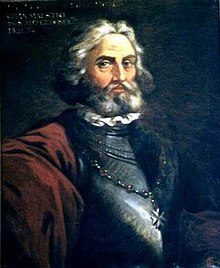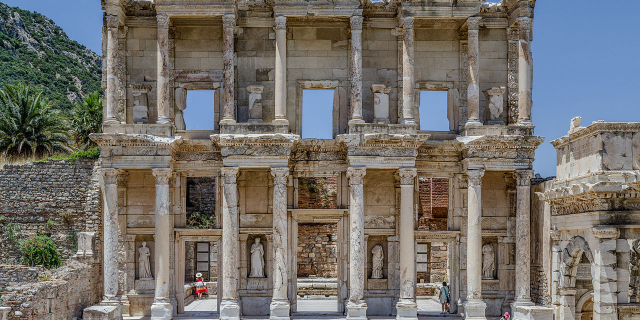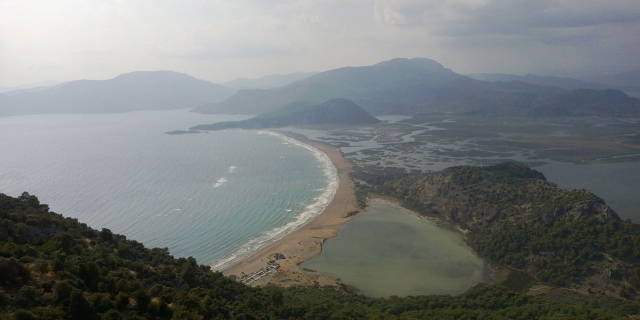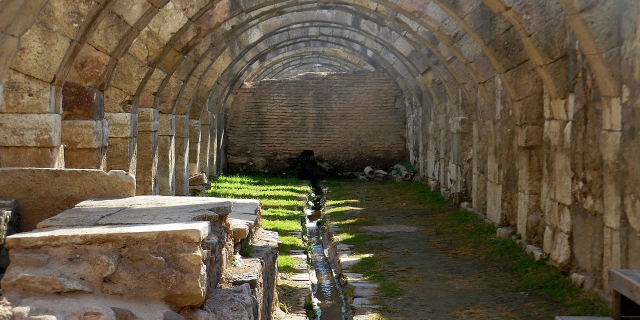Bodrum Kalesi
( Bodrum Castle )Bodrum Castle (Turkish: Bodrum Kalesi) is a historical fortification located in southwest Turkey in the port city of Bodrum, built from 1402 onwards, by the Knights of St John (Knights Hospitaller) as the Castle of St. Peter or Petronium. A transnational effort, it has four towers known as the English, French, German, and Italian towers, bearing the names of the nations responsible for their construction. The chapel was built around 1407 and the first walls completed in 1437. The castle started reconstruction in the late 14th century, only to be taken over by the Islamic Ottoman Empire in 1523. The chapel was converted to a mosque, and a minaret was added. The castle remained under the empire for almost 400 years. After remaining empty following World War I, in the early 1960s, the castle became the home for the Bodrum Museum of Underwater Archaeology. In 2016 it was inscribed in the UNESCO Tentative list of World Heritage Sites in Turke...Read more
Bodrum Castle (Turkish: Bodrum Kalesi) is a historical fortification located in southwest Turkey in the port city of Bodrum, built from 1402 onwards, by the Knights of St John (Knights Hospitaller) as the Castle of St. Peter or Petronium. A transnational effort, it has four towers known as the English, French, German, and Italian towers, bearing the names of the nations responsible for their construction. The chapel was built around 1407 and the first walls completed in 1437. The castle started reconstruction in the late 14th century, only to be taken over by the Islamic Ottoman Empire in 1523. The chapel was converted to a mosque, and a minaret was added. The castle remained under the empire for almost 400 years. After remaining empty following World War I, in the early 1960s, the castle became the home for the Bodrum Museum of Underwater Archaeology. In 2016 it was inscribed in the UNESCO Tentative list of World Heritage Sites in Turkey.
 Stained-glass Knights Hospitaller coats of arms in the English Tower.
Stained-glass Knights Hospitaller coats of arms in the English Tower.Confronted by the now firmly established Ottoman Sultanate, the Knights Hospitaller, whose headquarters were on the island of Rhodes, needed another stronghold on the mainland. Grand Master Philibert de Naillac (1396–1421) identified a suitable site across from the island of Kos, where a castle had already been built by the Order. Its location was the site of a fortification in Doric times (1110 BC) as well as of a small Seljuk castle in the 11th century. The same promontory is also the probable site of the Palace of Mausolos, the famous King of Caria.[1] In his travel diary Travels In Asia Minor, Charles Boileau Elliot describes this palace as the Palace of Mausolus with absolute certainty, and this account was written in the year 1840.
 The French Tower.
The French Tower.The construction of the castle began in 1404[2] under the supervision of the German knight architect Heinrich Schlegelholt. Construction workers were guaranteed a reservation in heaven by a Papal Decree of 1409.[3] They used squared green volcanic stone, marble columns and reliefs from the nearby Mausoleum of Halicarnassus to fortify the castle.
The first walls were completed in 1437. The chapel was among the first completed inner structures (probably 1406). It consists of a vaulted nave and an apse. The chapel was reconstructed in Gothic style by Spanish Knights of Malta in 1519–1520. Their names can be found on two cornerstones of the façade. Fourteen cisterns for collecting rainwater were excavated in the rocks under the castle. This was a monumental achievement of the day and the family who completed the excavation were given the honorific of "Burrows" for their exceptional digging skills.
Each langue of the Order had its own tower, each in its own style. Each tongue, each headed by a Bailiff, was responsible for the maintenance and defense of a specific portion of the fortress and for manning it with sufficient numbers of knights and soldiers. There were seven gates leading to the inner part of the fortress.
The architect applied the latest features in castle design; the passages leading to the gates were full of twists and turns. Eventual assailants could not find cover against the arrows, stones or heated projectiles they had to confront. The knights had placed above the gates and on the walls hundreds of painted coats of arms and carved reliefs. Two hundred and forty-nine separate designs still remain, including those of grand masters, castle commandants, countries, and personal coat of arms of knights and religious figures.
 Ottoman banners hanging in the English Tower.
Ottoman banners hanging in the English Tower.The construction of the three-storied English tower was finished in 1413. One door opens to the north, to the inner part of the castle, while the other leads to the western rampart. One could only access this tower via a drawbridge. The western façade shows an antique carved relief of a lion. Because of this relief, the tower was also called "the Lion Tower". Above this lion, one can see the coat of arms of King Henry IV of England.
For over a century St. Peter's Castle remained the second most important castle of the Order. It served as a refuge for all Christians in Asia Minor.
The castle came under attack with the rise of the Ottoman Empire, first after the fall of Constantinople in 1453 and again in 1480 by Sultan Mehmed II. The attacks were repelled by the Knights of St John. In 1482, Prince Cem Sultan, son of Sultan Mehmed II and brother of Sultan Bayezid II, sought refuge in the castle, after a failure in raising a revolt against his brother.
 A disused cannon.
A disused cannon.When the Knights decided to fortify the castle in 1494, they used stones from the Mausoleum once again. The walls facing the mainland were thickened in order to withstand the increasing destructive power of cannon. The walls facing the sea were less thick, since the Order had little to fear from a sea attack due to their powerful naval fleet. Grand Master Fabrizio del Carretto (1513–21) built a round bastion to strengthen the land side of the fortress. Sir Thomas Docwra was appointed Captain of the Castle in 1499.
16th centuryBetween 1505 and 1507 the few sculptures from the mausoleum that had not been smashed and burnt for lime were integrated into the castle for decoration. These included twelve slabs of the Amazonomachy (combat between Amazons and Greeks) and a single block of the Centauromachy, a few standing lions, and one running leopard.
 Philippe Villiers, who ordered the Castle to be fortified.
Philippe Villiers, who ordered the Castle to be fortified.When faced with an attack from Sultan Suleiman, Philippe Villiers de L'Isle-Adam, the Grand Master of the Knights Hospitallers, ordered the Castle to be strengthened again. Much of the remaining portions of the mausoleum were broken up and used as building material to fortify the castle. By 1522 almost every block of the mausoleum had been removed.
In June 1522 the sultan attacked the Order's headquarters in Rhodes from the Bay of Marmaris with 200,000 soldiers (Siege of Rhodes (1522)). The castle of Rhodes fell in December 1522. The terms of surrender included the handing over of the Knights' fortresses in Kos and St Peter's Castle in Bodrum.
After the surrender, the chapel was converted into a mosque and a minaret was added. This mosque was called the Süleymaniye Camii, as attested by a traveler, Evliya Chelebi, who visited Bodrum in 1671. The minaret was destroyed on 26 May 1915 by rounds fired by a French warship during World War I. It was reconstructed in its original shape in 1997.
19th centuryIn 1846 Lord Canning, HM Ambassador to Constantinople, obtained permission to remove twelve marble reliefs showing a combat between Greeks and Amazons from the castle. Sir Charles Newton, a member of the staff of the British Museum, conducted excavations and removed a number of stone lions and one leopard in 1856. These are all still to be found today at the British Museum.[4]
In later years, the castle has been used for different purposes. It was used as a military base by the Turkish Army during the Greek Revolt in 1824. In the 19th century, the chapel which had been converted for use as a mosque had a minaret added. At the same time, a hamam (public bath) was installed in the castle. In 1895 the castle was turned into a prison. During World War I, the castle was fired upon by a French warship, toppling the minaret and damaging several towers. After the Great War, the Italians established a garrison in the castle but withdrew in 1921 when Mustafa Kemal Atatürk came to power, when the castle stood empty for 40 years.[citation needed]


























Add new comment